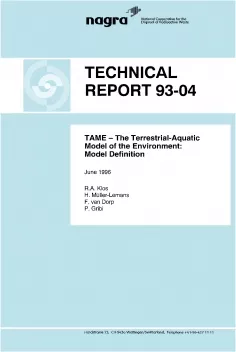
Technical Report NTB 93-04
TAME – The Terrestrial-Aquatic Model of the Environment:Model Definition
TAME – the Terrestrial-Aquatic Model of the Environment is a new computer model for use in assessments of the radiological impact of the release of radionuclides to the biosphere, following their disposal in underground waste repositories. Based on regulatory requirements, the end-point of the calculations is the maximum annual individual dose to members of a hypothetical population group inhabiting the biosphere region. Additional mid- and end-points in the TAME calculations are dose as a function of time from eleven exposure pathways, foodstuff concentrations and the distribution of radionuclides in the modelled biosphere.
A complete description of the mathematical representations of the biosphere in TAME is given in this document, based on a detailed review of the underlying conceptual framework for the model. Example results are used to illustrate features of the conceptual and mathematical models and to highlight areas where simplifications used to define the example biosphere must be revised in future applications. The end-point of dose is shown to be robust for the simplifying model assumptions used to define the biosphere for the example calculations.
TAME comprises two distinct sub-models – one representing the transport of radionuclides in the near-surface environment and one for the calculation of doses to individual inhabitants of that biosphere. The former is the result of a detailed review of the modelling requirements for such applications and is based on a comprehensive consideration of all features, events and processes (FEPs) relevant to Swiss biospheres, both in the present-day biosphere and in potential future biosphere states. Representations of the transport processes are derived from first principles. Mass balance for water and solid material fluxes is used to determine the rates of contaminant transfer between components of the biosphere system. The calculation of doses is based on existing representations of exposure pathways and draws on experience both from Switzerland and elsewhere.
Both sub-models are described in full and default datasets (i.e. those which are not strongly site specific) are included for the example calculations. The performance of TAME is compared and contrasted with that of earlier biosphere models used in Switzerland, demonstrating the correct working of the new model by limiting the scope to be similar to that of the older models, and illustrating the advantages of the new model when the full TAME dataset is used.
